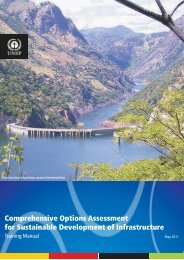MEASURING WATER USE IN A GREEN ECONOMY - UNEP
MEASURING WATER USE IN A GREEN ECONOMY - UNEP
MEASURING WATER USE IN A GREEN ECONOMY - UNEP
You also want an ePaper? Increase the reach of your titles
YUMPU automatically turns print PDFs into web optimized ePapers that Google loves.
Measuring water use in a green economy<br />
outlined above this refers to the overall<br />
available water minus the amount to be<br />
reserved for environmental requirements.<br />
The term is used following the approach of<br />
‘Human Appropriation of Renewable Fresh<br />
Water approach’ (HARFW). 1 However, accounts<br />
differ from that approach in several respects,<br />
in particular because they record returns of<br />
water and water stored in dams as accessible<br />
although it has been ‘appropriated’.<br />
Ecosystem capital accounts are based on<br />
physical statistical units (e.g. hydrological<br />
units, land-cover units) and not on economic<br />
units defined from their institutional status<br />
(e.g. enterprises, governments or households).<br />
In the case of terrestrial systems, they are<br />
basic land-cover units (e.g. forests, cropland<br />
areas, urban areas) which are in a second step<br />
combined into socio-ecological landscape units.<br />
For water, they are hydrological units (rivers,<br />
lakes, aquifers…). Rivers are considered as<br />
basic reaches re-combined into hydrological<br />
networks. River basins and sub-basin limits are<br />
considered explicitly in mapping terrestrial and<br />
hydrological statistical units.<br />
4.2.5 Key accounting variables in ECWA<br />
In addition to SEEA-W, the key accounting<br />
variables in ECWA relate to accessible water:<br />
• accessible freshwater stocks in aquifers<br />
(i.e. not including stocks that are<br />
inaccessible due to physical constraints,<br />
salinity, costs, etc.);<br />
• accessible freshwater stocks in lakes,<br />
dams and reservoirs (reservoirs increase<br />
accessibility by storing water and decrease<br />
it by generating additional evaporation);<br />
• actual evapotranspiration (ETA), including<br />
the use of water by rain-fed agriculture and<br />
managed forests, which is a measure of<br />
rain water accessed in situ;<br />
1 Human Appropriation of Renewable Fresh Water<br />
(HARFW) is defined in Vitousek et al. (1986). An estimation of<br />
HARFW was undertaken by Postel et al. (1996).<br />
• accessible ecosystem water flow, which is<br />
the available hydrological effective rainfall<br />
net of the water which is inaccessible<br />
because of the water regime (most of<br />
the flood water in temperate countries),<br />
pollution (river runoff needed to dilute<br />
pollution to acceptable levels and/or to<br />
maintain life in rivers), additional ETA<br />
induced by irrigation, and other uses.<br />
4.2.6 Aggregated accounting balances<br />
in ECWA<br />
The first aggregate is Total Ecosystem<br />
Accessible Water (TEAW), which summarises<br />
the various positive and negative changes in the<br />
water resource: flows and changes in stocks.<br />
This indicator can be computed by ecosystem<br />
units and river sub-basins and basins and<br />
aggregated at the level of administrative<br />
regions and countries, as well as according to<br />
any geographical or climatic zoning.<br />
TEAW will vary according to factors such as<br />
precipitation (positive or negative impacts);<br />
spontaneous evapotranspiration by crops<br />
or tree plantation (negative); additional<br />
evapotranspiration by irrigation (negative);<br />
storage in reservoirs (positive) and additional<br />
evaporation from reservoirs (negative);<br />
salinisation of groundwater (negative); pollution<br />
of rivers (negative); and transfers of water<br />
received (positive) or supplied (negative).<br />
The TEAW aggregate is not sufficient to<br />
assess the availability of water completely.<br />
The temporal variability of the meteorological<br />
conditions also needs to be taken into account,<br />
including a succession of wet and dry periods<br />
and the possible temporary severe stress that<br />
may result for people, agriculture and nature.<br />
ECWA could capture this risk by using a stress<br />
coefficient based on the number of days<br />
when plants cannot access any water in their<br />
growing season, recently calculated by EEA.<br />
Net Ecosystem Accessible Water is obtained<br />
by multiplying TEAW by the water stress<br />
coefficient. On that basis, a headline indicator<br />
derived from ECWA is Ecosystem Accessible<br />
Water Surplus, which compares withdrawals<br />
of water (abstraction, diversion to electricity<br />
53

















